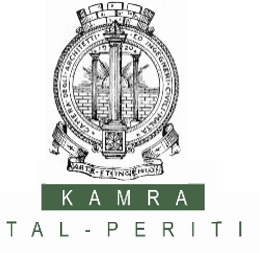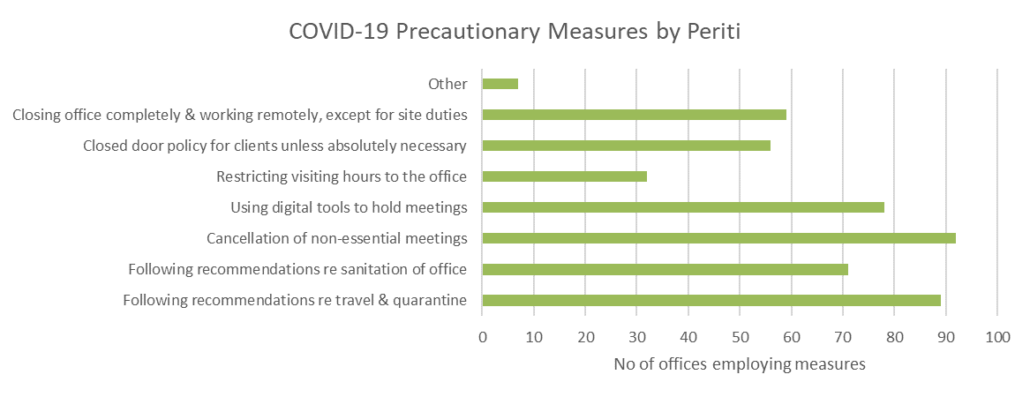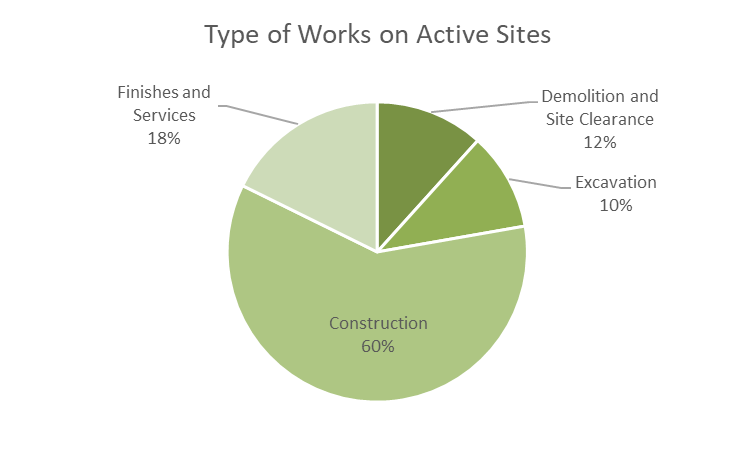DIR 09/20 | COVID-19 Pandemic: Third parties considered as vulnerable Individuals & social distancing
The Kamra tal-Periti is hereby giving notice to all members of the profession of a Directive that has been approved by the Council with regard to third parties considered as vulnerable individuals, as well as recommendations regarding social distancing on construction sites.
Third parties considered as vulnerable Individuals
Reference is made to Legal Notice 111 of 2020, which prohibits vulnerable individuals, as defined therein, from leaving their place of residence. In view of such restrictions, which are intended to safeguard the health of the persons concerned, the Kamra tal-Periti is hereby issuing the following Directives:
- Prior to carrying out any inspections for the purposes of preparing condition reports before the commencent of works or property valuations or any other reason which requires access to any property, periti are to ask their client to obtain a declaration from the owner of the property to be inspected as to whether or not the property is occupied by any person in the categories stated in the Legal Notice.
- No inspections for the purposes outlined above are to be undertaken under any circumstances if the property in question is occupied by persons in the categories listed in the Legal Notice.
- In the case of inspections that are required for the purposes of assessing potentially dangerous structures, either as a result of lack of maintenance or as a result of works underway on adjacent sites or any other reason whereby damage to the structure has been reported to the perit by the affected party, the perit is to request dispensation from the Superintendent of Public Health to carry out such inspection using the template Request for dispensation COVID-19 KTP 04_(Vulnerable persons)_inspections of property. The request is to be submitted to the Superintendent of Public Health, the Commissioner of Police, the Kamra tal-Periti, your Client and your Professional Indemnity Insurance provider, as well as others as you may deem appropriate. Contact details are inside template.
No inspections are to be carried out until the relevant clearance is issued by the Superintendent of Public Health.
Social distancing
Once clearance is received from the Superintendent of Public Health in terms of point 3 above, it is recommended that periti follow these recommendations, which are also applicable for any inspections to be carried out in third party property:
- Request that not more than one person is present in the property during the inspection, whenever possible
- Request that all windows and doors (internal and external) are kept open to avoid having to touch surfaces
- Request that you are allowed to inspect the damaged area without interruptions to limit your presence within the property, and that a distance of 2m is maintained between you and the person showing you around
- Carry your own sanitiser spray or gel, and use it before entering and after leaving the property
The COVID-19 Bulletin 15 states that the Police “have the right to intervene on groups of more than 5 people, and disperse them in such a way as to leave 2 metres between each one of them.” It is recommended that this measure is implemented on construction sites, and that you forward the link to all concerned so as to be observed at all times.
Perit Simone Vella Lenicker
President
DIR 08/20 | COVID-19 Pandemic: Periti within vulnerable groups // UPDATED
UPDATED: 28/03/2020
On Thursday 26th March 2020, the Deputy Prime Minister and Minister for Health Mr Chris Fearne gave notice of new restrictions that will be brought into force on Saturday 28th March 2020.
These measures were brought into force through Legal Notice 111 of 2020, and prohibit vulnerable individuals from leaving their place of residence, as outline therein.
These measures include an order prohibiting vulnerable individuals from leaving their place of residence. The list of vulnerable groups published in the COVID Bulletin Issue No 15 includes:
- Are over 65 years old
- Are pregnant
- Suffer from chronic illness
- Are insulin dependent diabetics
- Are on biological medication
- Had chemotherapy in the last six months
- Are undergoing immunosuppression (eg. had a transplant or HIV treatment)
- Are on renal dialysis
- Have respiratory problems and needed treatment in the last year
- Had cardiac problems in the last six months
- Are on oral steroids
In addition, those who live with people in this category will have to observe the lockdown or find alternative accommodation.
In view of such restrictions, and until further notice, periti in the above categories, or who live with people in such categories, are to immediately notify their clients of the restrictions imposed on them. In addition periti affected by these restrictions, and who are not in a position to delegate their responsibilities, are to follow the procedures outlined below:
- For all works where the closure of the construction site[1] does not pose any risk of danger or damage to the site itself or adjacent third parties[2], immediately submit a Notification COVID-19 KTP-01 (Vulnerable persons)_no risk using the template provided.
- For all works where the closure of the construction site poses a risk of minor damage to the site and/or adjacent third parties, immediately submit a Notification COVID-19 KTP-02 using the template provided. In this case, the Developer[3] is to be notified to forward such Notification to all affected third parties. It is recommended that you advise the Developer and their appointed Contractor/s to also submit to their respective insurance providers.
- For works where the closure of the construction site poses a risk of significant damage to, and/or a risk to the structural stability of, the site and/or adjacent third parties, immediately submit a Request for dispensation COVID-19 KTP 03_(Vulnerable persons)_risk to structural stability or significant damage using the template provided. In this case, no works that require the direction of the perit are to proceed until the dispensation is issued from the Superintendent of Public Health, and thereafter works are to proceed strictly in accordance with the content of the request for dispensation. In this case, the Developer is to be notified to inform any affected third parties. Once the works for which dispensation has been granted are complete, the perit is to proceed in accordance with points 1 or 2 accordingly.
- For works outlined in point 3 above, and where the perit is minded to not request dispensation from the Superintendent in view of the overriding reasons of public health, the perit is to immediately contact the Kamra tal-Periti for further guidance, outlining the sites which pose concern and the proposed way forward accordingly. Reference is also made to Directive 07/20 in this regard.
With respect to the cases outlined in point 3 above, periti are also encouraged to contact the Kamra tal-Periti if they require any specific guidance depending on the nature of the works under way.
In all cases, the relevant Notices are to be submitted to the following:
Superintendent of Public Health:
Building and Construction Agency:
Upload to eApps under the Avoidance of Damage to Third Parties tab
Planning Authority:
Upload to eApps under Correspondence
Commissioner of Police:
Via email to pulizija@gov.mt
Local Council of the Locality:
Via email – refer to https://localgovernment.gov.mt/en/lc/Pages/Local-Councils-Landing-Page.aspx/
Kamra tal-Periti:
buildingregs@kamratalperiti.org
Your Professional Indemnity Insurance provider:
As applicable
Additionally to (as applicable):
Client and/or site owner/s; Mason; Contractor/s; Project Supervisor in terms of LN 88 of 2018; any appointed Consultants
The relevant notices are to be issued on your letterhead and may be amended accordingly depending on the specific situation.
In addition, in all cases, the Project Supervisor is to be specifically instructed to ensure that the site is sealed off to prevent access by unauthorised persons.
As at the time of issuance of this Directive, the relevant Legal Notice had not as yet been published by Government. In view of this, periti are requested to follow further notifications from the Kamra that may slightly alter or affect this Directive once the Legal Notice is published.
With respect to periti who live with people in these vulnerable groups, while there is currently no restriction on their gong out to work, it is advisable to prepare yourselves for such eventuality.
Perit Simone Vella Lenicker
President
[1] For the purposes of this Directive a “construction site” means any open site where ongoing works involve demolition, site clearance, excavation, construction, finishes and/or services, and which are being carried out under your direction;
[2] For the purposes of this Directive “adjacent third parties” means any third party and/or their property and includes private and/or public third parties as well as the general public;
[3] For the purposes of this Directive “developer” has the same meaning ascribed to it in Legal Notice 136 of 2019.
DIR 07/20 | Change of Perit in cases of compliance with Orders and Guidance issued by the Superintendent of Public Health during the COVID-19 Pandemic
The Kamra tal-Periti is hereby giving notice to all members of the profession of a Directive that has been approved by the Council.
Periti are hereby authorised to refuse to sign a Change of Architect Form or to handover a project or assignment to another Perit in cases where they are following orders or guidance issued by the Superintendent of Public Health as part of the efforts to contain the spread of the COVID-19 pandemic in the Maltese Islands and as a result of which the former Perit is in any way reasonably prevented, restricted, limited or delayed from fulfilling his/her professional obligations in part or in full.
The Council of the Kamra tal-Periti will consider any actions by another Perit to take over a project or assignment in such circumstances as constituting “supplanting” in terms of Provision 4 of the Code of Professional Conduct.
Periti are reminded that the Council of the Kamra tal-Periti is empowered to take appropriate action in terms of the Periti Act in case of breach of this Directive.
Perit Simone Vella Lenicker
President
CIR 06/20 | COVID-19 – What is the Kamra doing? // Update 4
I would like to start off by thanking each and every one of you for your constant support and feedback. We understand that many of you are facing very challenging times, and that part of your frustrations are fuelled by the element of uncertainty as to what is to be expected in the near future.
On our part, we have been working incessantly to ensure that the interests of the profession and our clients, and the safety of all those who work on construction sites are safeguarded. Our efforts during the past few days have focussed primarily on three aspects, namely:
- Weathering the storm to save businesses and jobs
- Planning Commission meetings and processes
- Building regulations and construction sites
Below please find a detailed outline of progress achieved to date.
1. Weathering the storm to save businesses and jobs
The Kamra tal-Periti has been having practically daily meetings with the Chamber of Advocates, the Kunsill Notarili ta’ Malta, the Dental Association of Malta, and the Malta Institute of Accountants over the past two weeks. As representatives of these regulated professions we have come together to submit proposals for an economic recovery package to Government, which focuses on all sectors of the economy, including of course our sector as a whole.





The package is based on two main fronts. Firstly, it proposes a phased approach, targeting the immediate period up to July, following which it will focus on the recovery period up to April next year with incisive and tailor-made economic remodelling, and beyond then the measures proposed will be aimed at relaunching businesses to begin thriving again following what will undoubtedly be a downturn in the economy.
The second front is based on the principles of burden-sharing, wherein Government, the business community, employees and the banks come together to collectively take the country forward in a healthy and sustainable manner. In the immediate period, the focus must be on job retention – businesses have invested in their people, who they consider as part of the family and who are tuned in to the ethos of the company, and therefore the focus must be on ensuring that employees are retained on the payroll for as long as possible. Beyond that, it is imperative to ensure that we can weather the storm together, with a focus on the general well-being of all of society.
In order to achieve this, measures must be targeted along two streams, namely facilitating business operations through cost reductions, flexibility in working conditions, cash flow measures, and lending facilities, and on the other hand bolstering the liveability of employees through targeted measures to reduce their cost of living at this critical moment and to ensure that their needs are adequately catered for.
The Chambers and Associations mentioned above presented an initial proposal to Government last Friday, which was followed up with a detailed proposal backed up by market research last Monday. We are currently awaiting notice for a meeting wherein these proposals can be presented to Government in detail.
While at this point we cannot provide further detail, nor can we give any guarantees, we assure you that we are doing everything within our power to ensure that our representations are heeded. On this point, the Council thanks you for participating in the surveys that have been sent out, since these allow us to keep tabs on the situation and to reinforce our discussions with Government.
We hope to be able to update you on this matter in the coming days.
2. Planning Commission meetings and processes
As already outlined in Circular 05/2020, Planning Commission hearings were cancelled last week following recommendations by the Superintendent of Public Health to exercise social distancing and cancel non-essential meetings. The Authority, however, intends to proceed with Board and Commission hearings.
In view of this, Council submitted a protocol to be followed for the resumption of hearings, including the use of videoconferencing technology, which will ensure this can be done without exposing periti and their clients. We are confident that our proposals will be taken on board, and reiterate our commitment to ensure that the processes to be adopted will be implemented smoothly and efficiently, and that the health and safety of all involved is ensured. In addition to this, discussions are also ongoing regarding certain planning processes in view of the current situation.
We expect announcements to be made soon in this respect.
3. Building regulations and construction sites
On Wednesday afternoon, a meeting was held with the Building Industry Technical Committee set up by the Prime Minister. The public consultation document A Modern Building and Construction Regulation Framework for Malta prepared by the Kamra tal-Periti and endorsed by its Extraordinary General Meeting of 2019, and which was also endorsed by all the main stakeholders in the industry following a consultation process carried out by the Council, was presented to the Committee in detail. We understand that the Committee is meeting with other stakeholders and will be making its recommendations to the Prime Minister shortly.
The Council has also presented to Government its proposals with regard to construction sites in view of the current coronavirus crisis. The concerns raised are focussed on the processes that need to be in place in the eventual possibility of a lockdown, and also the safety precautions to be taken on construction sites and inspections of properties specifically for periti in the interim period. A meeting has been requested with the Building and Construction Agency, the Planning Authority and the Superintendent of Public Health. Again, we will update you accordingly once a position is agreed to.
I cannot emphasise enough how important it is for you to keep in touch with us via email on info@kamratalperiti.org, Facebook Messenger, and the Periti Discussion Group on Facebook.
Meanwhile, we will continue focussing all of our attention on ensuring that we pull through the current crisis together.
Perit Simone Vella Lenicker
President
Video: Eric Bartolo
CIR 05/20 | COVID-19 Planning Commission Hearings // Update 3
As you are aware, Planning Commission hearings were cancelled last week following recommendations by the Superintendent of Public Health to exercise social distancing and cancel non-essential meetings. However, over the weekend periti and applicants began receiving notifications that hearings were to take place this week.
The Council immediately sought clarifications from Government, particularly in view of the fact that LN 75 of 2020 prohibited the hearings from proceeding. Discussions were held with Minister Aaron Farrugia and with the Planning Authority about the reasons why such a decision was taken, given the risks to periti and their clients.
Council submitted a protocol to be followed for the resumption of hearings, including the use of videoconferencing technology, which will ensure this can be done without exposing periti and their clients. The Kamra’s proposals are being actively considered by Minister Farrugia and the Planning Authority. Meanwhile it is noted that the prohibition imposed by LN 75 of 2020 has now been lifted through the coming into force of LN 97 of 2020.
The Council is confident that its proposals will be taken on board, and reiterates its commitment to ensure that the processes to be adopted will be implemented smoothly and efficiently, and that the health and safety of all involved is ensured.
Perit Simone Vella Lenicker
President
PR 04/20 | Quality of life and public safety should under pin future of construction industry
The Kamra tal-Periti met with Prime Minister Robert Abela, Minister Aaron Farrugia, Minister Ian Borg and Parliamentary Secretary Chris Agius yesterday afternoon to discuss the two public safety crises that have engulfed our country: the outbreak of the COVID-19 pandemic and the lack of adequate regulation in the construction industry, which recently led to the premature demise of Miriam Pace.
Construction industry crisis
On the construction industry crisis, Kamra tal-Periti President, Simone Vella Lenicker, acknowledged the role of some members of the profession. She also acknowledged the fact that Government had recognised the need for change, which it committed to implementing in the Letter of Commitment signed in August 2019. This outlined a number of reforms which the Kamra has been striving for, including:
- The licensing and classification of contractors by the State to ensure they are qualified to shoulder their responsibilities, and give the public and consumers peace of mind;
- The consolidation of laws and regulations whose remit is scattered in 22 different public entities;
- The introduction of regulations covering the design of permanent works which would fall under the responsibility of periti and engineers, and the execution of temporary works which would fall under the responsibility of contractors, thereby providing simplicity and clarity of the roles within the industry;
- The enactment of the long-overdue amendments to the Periti Act.
Vella Lenicker welcomed the Prime Minister’s statement in Parliament that responsibilities on site should follow the Civil Code, which underscores the symmetric responsibilities of periti and contractors. To this end, she called on Government to revise LN 136 of 2019 to eliminate the ambiguities about site responsibilities that it brought about.
Government must also look at the issues besetting the industry in a holistic and comprehensive manner, as the Kamra tal-Periti has been calling for since 2007. Among these issues was the ill-advised obsession of the Planning Authority to insist on the indiscriminate provision of underground carparking, which is leading to the dangerous practice of excavating between party walls in narrow sites, as well as causing wider problems of waste management, traffic, air pollution and a rapid deterioration of the quality of life of Malta’s citizens.
Prime Minister Abela welcomed the Kamra’s contributions and detailed recommendations and looked forward to collaborating further with the Kamra in introducing the necessary reforms in the industry.
COVID-19 Pandemic
Vella Lenicker outlined the profession’s concerns about the risks to public safety should a national lockdown be announced suddenly. She explained that it is not advisable to abruptly shut down all construction sites, as some may present a greater risk to public safety if they are abandoned without the necessary precautions being put in place to ensure structural stability. She also stated that there may also be instances where properties may require urgent maintenance or repairs during the lockdown period, and provisions should be made for such situations.
It was agreed that, although there is no indication as yet from the public health authorities that a lockdown is imminent, separate discussions would be held with the relevant Ministries to prepare for such an eventuality should it arise.
CIR 04/20 | COVID-19 Precautionary Measures in view of potential site closures // Update 2
The COVID-19 situation in Malta is, as you are aware, progressing, with local transmissions now being recorded. While there is no official indication of a potential lockdown situation as at the time of writing, it is important that we prepare ourselves for this eventuality.
The Kamra tal-Periti will issue Directives as required and as the situation evolves.
STAGE 1: SOCIAL DISTANCING FOR PERITI
Reference is to be made to the Kamra’s Circular 03/2020 which proposes various measures to be taken by your office to practise social distancing, as recommended by the Authorities. The Kamra notes with satisfaction that many offices have already implemented these measures. Following a survey carried out across the profession, to which 105 offices submitted their replies by 1pm on the 17th March 2020, the following results were registered:

You are encouraged to continue putting these measures into effect, and to encourage your colleagues and other professionals to do the same.
STAGE 2: IDENTIFICATION OF OPEN SITES
It is recommended that you immediately carry out a preliminary risk assessment of open sites under your supervision, and that you classify them as follows:
- Sites which currently involve primarily Demolition and/or Site Clearance Works
- Sites which currently involve primarily Excavation Works
- Sites which currently involve primarily Construction Works
- Sites which currently involve primarily Works related to Finishes and Services
For each of the above Classifications, identify the risks that may arise in the hypothetical scenario of a Government-imposed instantaneous lockdown of the construction industry, as follows:
- Risk to structural stability of site and/or to adjacent parties*
- Risk of significant damage to site and/or to adjacent parties*
- Risk of minor damage to site and/or adjacent parties*
- No risk to site and/or adjacent parties*
* “adjacent parties” includes private third parties and their property, the general public, and/or public property
The periti who responded to the survey are responsible for 725 active sites. The type of works currently being undertaken are primarily as follows:

It is recommended that all efforts are focussed on those works which pose a risk to the site and/or to adjacent parties during this current Stage, in order to minimise such risks pending further notices from Government regarding a potential lockdown.
In all cases of ongoing works, it is recommended that you communicate with your Client, their appointed Contractor/s and Project Supervisors (in terms of LN 88 of 2018), in order to assess the evolving situation and to identify the risks, if any, in terms of potential spread of the virus on the site itself. This should include confirmation in writing from all persons on site that they have not travelled in the past three weeks, and that they have not been in contact with persons who travelled in the past three weeks – in case of persons who do not meet these criteria, request that these are not allowed to access the site, and that they follow the measures imposed by Government regarding self-quarantine. In case of non-compliance, report to the Commissioner of Police on 2122 4001-9 or pulizija@gov.mt
If works are being carried out in confined spaces, and these can be postponed, liaise with the Client and the contractor accordingly in the interest of public health and safety.
It is also recommended that, together with the Client, Contractor/s and Project Supervisor, you prioritise those works that may pose a threat to the site itself and/or to adjacent third parties, including works relating to water-tightness.
It is also recommended that, in agreement with the Client, you postpone the commencement date of any new works until after the pandemic is declared to be over.
STAGE 3: LOCKDOWN SITUATION
Although no indication has been given by Government of an immediate lockdown situation that would affect the industry, it is nevertheless important to be prepared for such eventuality.
The Council of the Kamra tal-Periti has communicated with Government in this regard and is awaiting feedback. The Council will update you as soon as possible in this respect.
Perit Simone Vella Lenicker
President
Affiliations
The Kamra tal-Periti is affiliated with the Architects' Council of Europe (ACE), European Council of Civil Engineers (ECCE), Union International des Architects (UIA), Union of Mediterranean Architects (UMAR), Commonwealth Architects Association (CAA), and the Malta Federation of Professional Associations (MFPA).
Contact Us
Kamra tal-Periti
The Professional Centre
127, Sliema Road
Gzira GZR 1633
Malta
+356 2131 4265
info@kamratalperiti.org
Office Opening Hours
Mon-Fri: 8:00am - 11:00am
